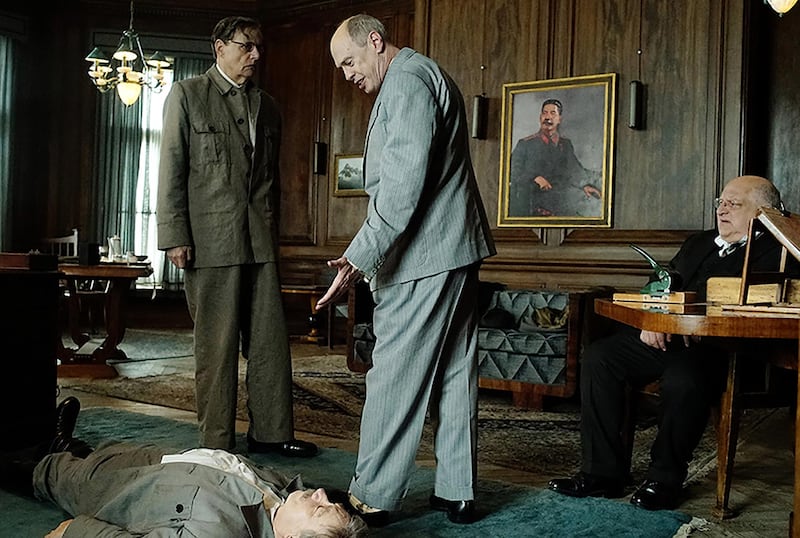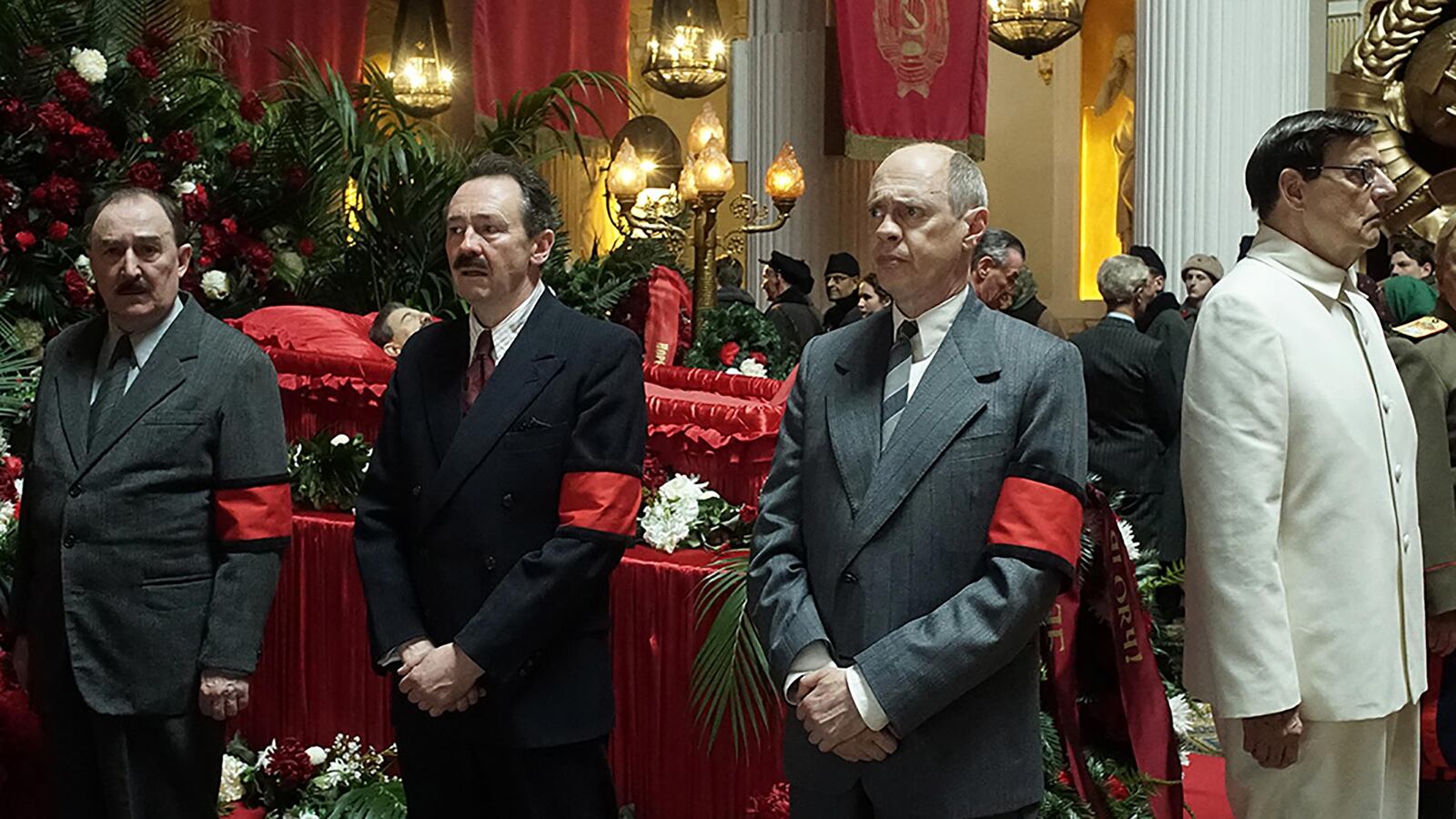LONDON – When is it okay, or safe to laugh at monsters?
Not in their presence. Nobody has been recorded making a joke at the expense of Adolf Hitler while in his company. Nor did anyone test the sense of humor while in the company of that other monster of the twentieth century, Joseph Stalin.
If you do make monsters a subject of ridicule while they are still alive it’s wiser to do it from a distance, as Charlie Chaplin did with Hitler in The Great Dictator. Or, after they are long dead, as Mel Brooks did, breaking a whole raft of taboos, with the Nazi chorus line in The Producers.
Stalin, however, is a more slippery monster than Hitler. For most of his lifetime he somehow escaped the same degree of odium attached to Hitler. And yet when it came to exterminating millions of people as deliberate acts of policy they were in the same league: 6 million Jews, at minimum, for Hitler and 7 million peasants for Stalin.
Part of the reason for this difference in perceptions is that during World War II we were sold the idea of cuddly Uncle Joe as our ally in the mission to destroy Nazi Germany. Never mind that his end game was to enslave the whole of Eastern Europe.
Also, Stalin was the enforcer of an ideology, Marxist Leninism, that outlived him, and did not carry the pungent stigma of Nazism. After all, Marxist Leninism still has many millions of adherents who are considered respectable, if not entirely sane.
But make no mistake, Stalin did direct a regime of terror that penetrated every level of life in the Soviet Union and from which nobody was safe. The peasants were victims of the enforced collectivization of farms between 1931 and 1933, felled deliberately by a combination of famine and disease. In a purge of the army’s officer corps only 10 percent survived.
This is not a picture that Vladimir Putin’s Russia wants to revisit on the centenary of the coming to power of the Bolsheviks in 1917. Indeed, the Russian Revolution seems to have quietly lost its place as the founding legend of modern Russia. After all, a system based on the idea that there should be no private ownership of property is discomfortingly discordant in the age of the oligarchs.
But a bomb has just burst into this bout of historical amnesia – a brilliant explosion of satirical cinema, The Death of Stalin, the work of Armando Iannucci, the British creator of Veep and a series of sendups of political malfunction that began years ago with a merciless take on Tony Blair’s socialism, The Thick of It.
The movie’s title is misleadingly specific. It does feature one of the most ghoulish bunches of gangsters to ever gather in jumpy orbit around an erratic psychopath. They do carry the names of Stalin’s immediate henchmen. The action does take place in Moscow and Stalin’s dacha in 1953. But there is something larger going on. The story plays with all the components of terror but does not succumb to or exploit the terror. Instead, it exposes the absurdity of terror and becomes, through ridicule, a universal parable about the ultimate impotence of megalomania.
And what could be more terrifying than the person of Lavrentiy Beria, Stalin’s secret police chief? For years Beria remorselessly served Stalin’s paranoia – purging thousands of imaginary traitors, perfecting ever more hideous forms of torture and humiliation, lasciviously pouncing on women for whom resistance would likely be fatal.
In the film, Beria is the orchestrator of Stalin’s death, without being the assassin. The guards outside Stalin’s quarters in his dacha hear the impact of a body hitting the floor but are too scared to open the doors to investigate. In fact, as was the case, Stalin had suffered a massive stroke, but he was left undisturbed for a whole night.
When he is discovered, he is still alive. The issue – grasped immediately by Beria – is whether a half-dead Stalin is more dangerous than a dead Stalin. Beria, surrounded by less decisive gang members, otherwise known as the ruling presidium of the Soviet Union, rules that no doctors shall be called.
The beauty of this moment as drama (and comedy) is that it drops every one of the principal players into the same hole – the sudden and absolute vacuum of power left when a tyrant dies. Who has the balls to move in? They all look at each other. But after all the years of submission to the greater will nobody dares to show his hand. No succession has been prepared.
Instead, Iannucci has them being so clumsy as they move the corpse from the floor to a bed that one of them is briefly entangled with the corpse.
Where did this macabre regime really begin?
As it turned out, a few days after I saw The Death of Stalin I was sent, at warp speed, back to the decisive days of the October Revolution. More precisely, to the authorized film version of those events as personally approved (with cuts) by Stalin himself in 1928.
Barely a decade after the revolution the greatest of Russian film directors, Sergei Eisenstein, made October in which the final Bolshevik uprising in St. Petersburg, then the Russian capital, was re-enacted using the actual locations. Here in London a newly restored print had a one-night screening, with the London Symphony Orchestra playing a score originally written by the German composer Edmund Meisel.
By the time Eisenstein completed the film all the bloody factional struggles among the Bolshevik leadership were settled. Lenin had died in 1924, after suffering three strokes. Stalin was established as a ruthless tyrant. When he viewed Eisenstein’s final cut he ordered the removal of all scenes showing his most formidable ideological rival, Leon Trotsky, who, in the new Orwellian world of the Kremlin, had become a non-person. (On Stalin’s orders Trotsky was later assassinated in Mexico.)
Nonetheless, what’s striking about October, when viewed in its role as the most faithful version of Bolshevism’s founding myth, is that there is no single dominant hand guiding the revolution. Lenin is seen fleetingly as a mesmerizing orator, but not a man of action. The real hero is a collective: the great ineluctable tide of the risen proletariat, at first decimated as they gather in public places by the tsfar’s machine gunners, and finally storming the Winter Palace in the onset of what John Reed indelibly stamped as Ten Days That Shook The World.
As film making in the service of a tyranny, October – for all the limitations of early silent cinematography – stands in its creative power with the notorious work of Leni Riefenstahl. The difference is that Riefenstahl, particularly with her masterpiece, Triumph of the Will, was in the business of deifying Hitler whereas Eisenstein miraculously managed to avoid a role in spreading the cult of Stalin at a time when his glowering Big Brother portrait was a mandatory furnishing of every public space and building.
Eisenstein was the master of the single image that sears a permanent mark in the memory: the baby carriage bouncing down the steps in Odessa as the city is bombarded in Battleship Potemkin and, in October, a white horse harnessed to a cart on the edge of a rising drawbridge, at first left hanging perilously and then finally plunging into the canal. (The bridges were raised in an attempt to keep the revolutionaries out of the city center.)
Other images use metaphor as propaganda. Stylish bourgeois women with heavily made up faces stab viciously at wounded proles with their umbrellas. Members of the provisional government, about to be expunged, are shown as bickering dolts. Close-ups of chandeliers in the Winter Palace shaking from the shock of distant gunfire are brilliantly used as a premonition of the end of the Romanovs. More crudely, tiers of champagne bottles in the cellars spurt torrents of wine as they are raked with rifle fire. Working without sound, and with exposition left to a few subtitles, Eisenstein spoke volumes through his eye.

Few people will ever get to see October. In Russia, Putin is playing down the centenary of the revolution. There is talk of removing Lenin’s embalmed body from the tomb in Red Square, the shrine of world-wide Marxist-Leninism, and a re-burial inside the Kremlin. Putin restored the old Soviet national anthem in 2000, albeit with new lyrics, but since then he has cooled on the Stalin legacy as his own cult has grown more to reflect the manner and trappings of a tsar; like the cult of Stalin, the cult of Putin brooks no competing allure.
That’s why Iannucci’s timing is perfect. What could be more of an affront to the idea of a leadership cult than this glorious, impudent, coruscating farce?
There are no fake Russian accents. The actors speak in their own natural voices and have only a fleeting physical resemblance to the characters they play. When Jeffrey Tambor, playing Georgi Malenkov, the vacillating party hack who briefly succeeded Stalin, says “you can kiss my Russian arse” with an appropriate gesture it’s as though he’s channeling Al Pacino. The eventual successor, Nikita Khrushchev, is played with stealthy menace by Steve Buschemi. The magic of the direction is that, even when they are playing the lines straight, the body language and timing are comical: “Kill him. Take his body to the church and dump him in the pulpit,” deadpans Simon Russell Beale, playing Beria as he issues the latest list of those to be liquidated.
There have been stories that the Kremlin finds the idea of turning Stalin’s death into farce offensive, even of the film being banned in Russia. Iannucci himself has dismissed this as nonsense. For sure, Putin is ultra sensitive about how his cult as the bare-chested strong man is promoted and, no doubt, he would not have liked how he has become, alongside Trump, a regular target of Saturday Night Live’s mimicry.
Of course, Putin and Trump are both thin-skinned sociopaths. As such, one of the things they find intolerable is ridicule. Luckily, so far neither of them has reached the point where they can retaliate with Stalin-like terror and turn people like Iannucci into non-persons. So let’s keep laughing at them. It might just be the most effective response.






